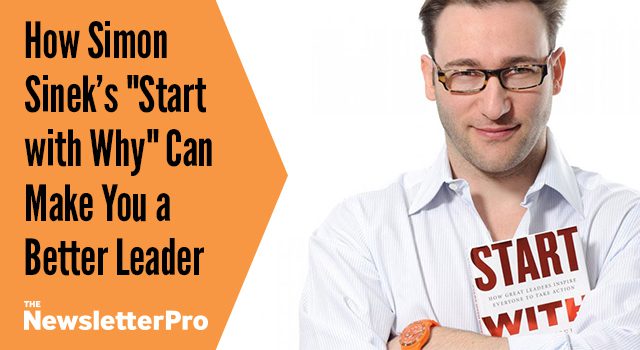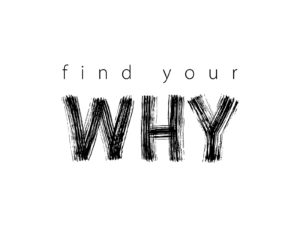Here’s a big question for you: How confident are you in your business approach? If you’re like most entrepreneurs, you’re probably pretty self-assured in the direction you’re steering the ship. But if you ask bestselling author Simon Sinek, you’re probably going about the whole thing completely backward. So here’s another big question for you: Why do you do what you do?

Sure, you wake up, take a shower, get ready for the day, and then head off to work. You deal with your employees (or your boss) and try to make a dollar or two for yourself and the company. Then you go home, spend time with your family, watch some TV, manage your personal affairs, and go to bed.
But again, why?
What about your business? Why do some companies and organizations drive innovation and reap massive profits while others struggle to barely stay afloat?
Questions like these drove Simon Sinek to write his massively influential book, “Start with Why: How Great Leaders Inspire Everyone to Take Action,” a vital read for anyone seeking to hone in on their purpose, live their lives with intention, and tap into their personal and professional potential.
Aimlessness Is The Enemy
 As Sinek puts it, everybody knows what they do. Whether it’s hopping out of bed in the morning and cracking a couple eggs into a pan, or your company selling IT solutions to small businesses, the “what” is easy. Fewer individuals and organizations know how they do what they do. Maybe your business offers a unique selling proposition, or maybe you personally keep a strict, productive schedule. But rarely does a person or organization truly know why they do what they do.
As Sinek puts it, everybody knows what they do. Whether it’s hopping out of bed in the morning and cracking a couple eggs into a pan, or your company selling IT solutions to small businesses, the “what” is easy. Fewer individuals and organizations know how they do what they do. Maybe your business offers a unique selling proposition, or maybe you personally keep a strict, productive schedule. But rarely does a person or organization truly know why they do what they do.
Pretty much everyone, Sinek argues, is doing everything backward. Instead of filtering everything we do through a singular purpose (that ever-important “why”), we’re floundering on the surface level, falling into patterns without inspiring ourselves, our co-workers, or our customers.
Sinek argues that when we think from the outside in, we may be able to communicate vast amounts of data or selling points to potential prospects or friends. But we can’t drive behavior. What changes the way people think and act is the “why.” If you don’t know the purpose behind your actions, it’s going to be impossible to influence anybody to do anything, much less buy what you’re selling.
Finding Your “Why” Is The Solution
 But even if you understand that you need to reexamine your priorities and find that precious “why,” it can be difficult to know just where to start.
But even if you understand that you need to reexamine your priorities and find that precious “why,” it can be difficult to know just where to start.
The key, as Sinek states, is to start from the inside out, rather than the outside in. Every one of the inspired leaders and businesses you read about on Forbes and Businessweek thinks, acts, and communicates from a core purpose and conviction. These organizations know what they’re about. This approach, in which “why” forms the central layer, “how” forms the next, and only then “what” gets its say, he calls “The Golden Circle.”
Sinek uses the underlying philosophy behind Apple as the prime example of this approach. He writes that if Apple were like most other companies, they’d start from the outside of the circle, the “what.”
What do they do? They sell fantastic computers that outdo their competition. Maybe they’d throw in a call to action, then expect people to act on this airy information. “We make great computers,” Sinek illustrates, “They’re beautifully designed, simple to use, and user-friendly. Wanna buy one?”
Obviously, this isn’t the most compelling way to bring in new customers. But that’s not actually what Apple is about. They articulate their purpose across all their marketing, their hiring materials, and the fabric of their organization, more like this:
“Everything we do, we believe in challenging the status quo. We believe in thinking differently. The way we challenge the status quo is by making our products beautifully designed, simple to use, and user-friendly. And we happen to make great computers. Wanna buy one?
It might seem like a simple shift, but it’s anything but. By starting from a foundation of clear purpose, they’re able to convince their customers and employees to actually believe in the organization and its products, rather than just going through the motions and probably ignoring Apple altogether.
Sinek doesn’t think his “Golden Circle” is anything new. Far from it; he argues that it’s simply a codification of the way all great people and companies have thought through history. Martin Luther King, Jr., the Wright brothers, and Steve Jobs all realized their potential by starting with that simple question: Why do you do what you do?
So, why do you do what you do? You better get cracking and find out.






